Page 208 of 474
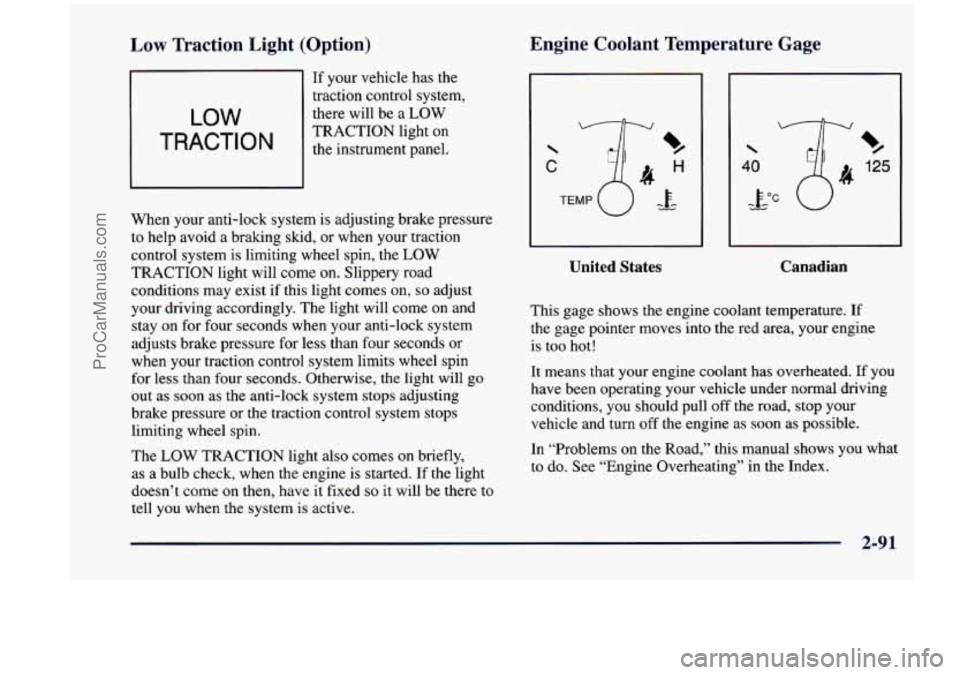
Low Traction Light (Option)
LOW
TRACTION
If your vehicle has the
traction control system,
there will be a LOW
TRACTION light on
the instrument panel.
When your anti-lock system
is adjusting brake pressure
to help avoid
a braking skid, or when your traction
control system is limiting wheel spin, the LOW
TRACTION light will come on. Slippery road
conditions may exist if this light comes
on, so adjust
your driving accordingly. The light will come on and
stay on for four seconds when your anti-lock system
adjusts brake pressure for less than four seconds or
when your traction control system limits wheel spin
for less than four seconds. Otherwise, the light will
go
out as soon as the anti-lock system stops adjusting
brake pressure or the traction control system stops
limiting wheel spin.
The
LOW TRACTION light also comes on briefly,
as a bulb check, when the engine is started. If the light
doesn’t come on then, have it fixed
so it will be there to
tell you when the system is active.
Engine Coolant Temperature Gage
C
%
125
%
United States
I
Canadian
This gage shows the engine coolant temperature. If
the gage pointer moves into the red area, your engine
is too hot!
It means that your engine coolant has overheated. If you
have been operating your vehicle under normal driving
conditions, you should pull off the road, stop your vehicle and turn
off the engine as soon as possible.
In “Problems on the Road,” this manual shows you what
to do. See “Engine Overheating” in the Index.
.. .
ProCarManuals.com
Page 209 of 474
Engine Temperature Warning Light
This light will come on
when your engine gets
too hot.
Low Coolant Light
If this light comes on,
your system is low on
coolant and the engine
may overheat.
If this light comes on, it means that your engine coolant
has overheated. If you have been operating your vehicle
under normal driving conditions, you should pull
off the
road, stop your vehicle and turn off the engine as soon
as possible. See
“Engine Coolant” in the Index and have your
vehicle serviced as soon as possible.
In “Problems on the Road,” this manual shows what to
do. See “Engine Overheating” in the Index.
2-92
ProCarManuals.com
Page 293 of 474
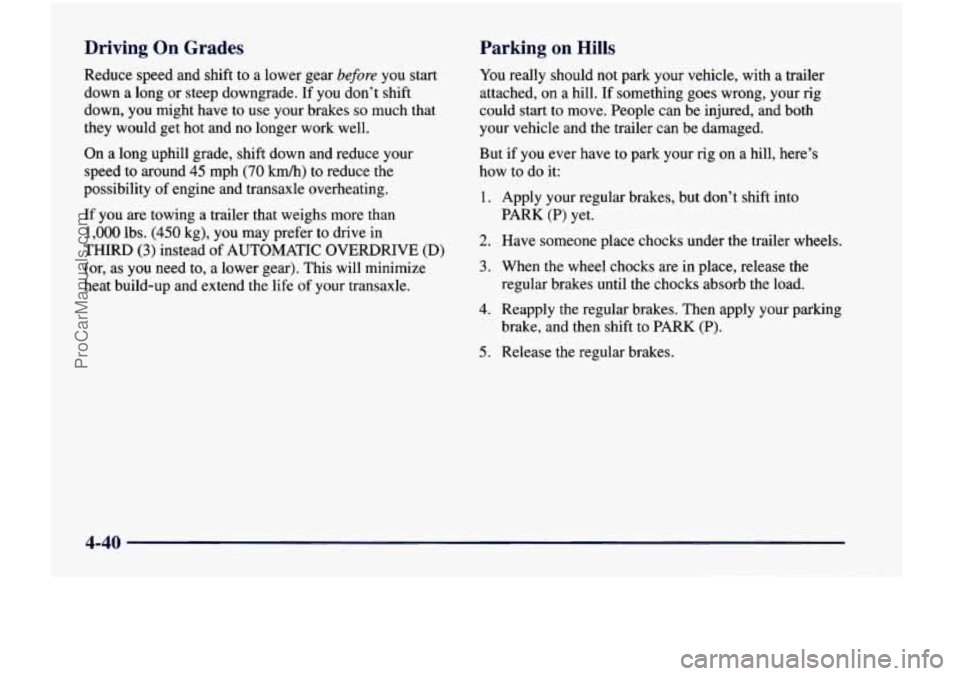
Driving On Grades
Reduce speed and shift to a lower gear before you start
down
a long or steep downgrade. If you don’t shift
down,
you might have to use your brakes so much that
they would get hot and no longer work well.
On a long uphill grade, shift down and reduce your
speed to around
45 mph (70 kmih) to reduce the
possibility of engine and transaxle overheating.
If you are towing a trailer that weighs more than
1,000 lbs. (450 kg), you may prefer to drive in
THIRD
(3) instead of AUTOMATIC OVERDRIVE (D)
(or, as you need to, a lower gear). This will minimize
heat build-up and extend the life
of your transaxle.
Parking on Hills
You really should not park your vehicle, with a trailer
attached, on a hill. If something goes wrong, your rig
could start to move. People can be injured, and both
your vehicle and the trailer can be damaged.
But if you ever have to park your rig on a hill, here’s
how to do it:
1. Apply your regular brakes, but don’t shift into
PARK (P) yet.
2. Have someone place chocks under the trailer wheels.
3. When the wheel chocks are in place, release the
regular brakes until the chocks absorb the load.
4. Reapply the regular brakes. Then apply your parking
brake, and then shift to PARK (P).
5. Release the regular brakes.
4-40
ProCarManuals.com
Page 298 of 474
0 Section 5 Problems on the Road
Here you’ll find what to do about some problems that can occur on the road.
5-2
5-2
5-3
5-8
5-13
5-24
Hazard Warning Flashers
Other Warning Devices
Jump Starting
Towing
Your Vehicle
Engine Overheating
If a Tire Goes Flat
5 -24
5-24
5-34
5-35
Air Inflator (Option)
Changing a Flat Tire
Compact Spare Tire
If You’re
Stuck: In Sand, Mud,
Ice or Snow
5-1
ProCarManuals.com
Page 310 of 474
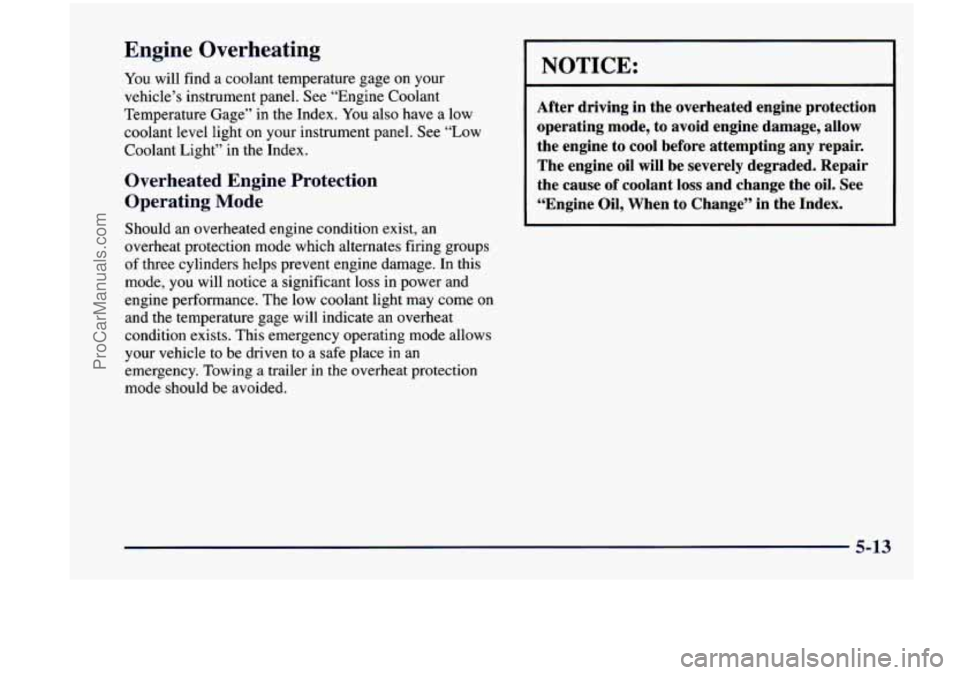
Engine Overheating
You will find a coolant temperature gage on your
vehicle’s instrument panel.
See “Engine Coolant
Temperature Gage” in the Index.
You also have a low
coolant level light on your instrument panel. See “Low
Coolant Light’’ in the Index.
Overheated Engine Protection
Operating
Mode
Should an overheated engine condition exist, an
overheat protection mode which alternates firing groups
of three cylinders helps prevent engine damage. In this
mode, you will notice a significant loss in power and
engine performance. The low coolant light may come
on
and the temperature gage will indicate an overheat
condition exists. This emergency operating mode allows
your vehicle to be driven to a safe place in an
emergency. Towing
a trailer in the overheat protection
mode should be avoided.
NOTICE:
I
After driving in the overheated engine protection
operating mode, to avoid engine damage, allow
the engine to cool before attempting any repair.
The engine oil will be severely degraded. Repair
the cause of coolant loss and change the
oil. See
“Engine Oil, When
to Change” in the Index.
5-13
ProCarManuals.com
Page 315 of 474
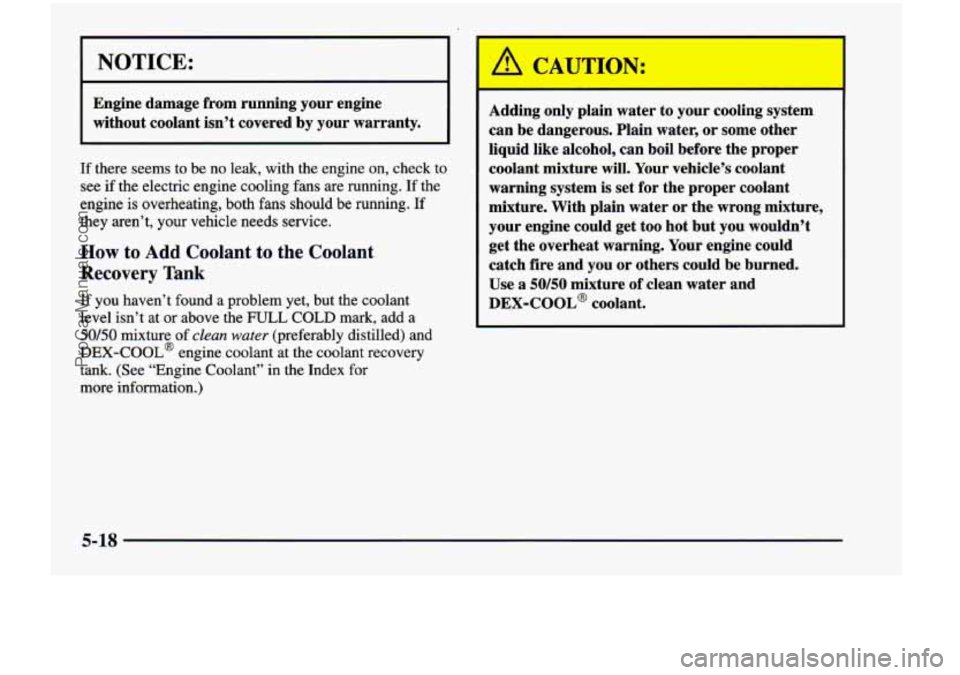
NOTICE:
Engine damage from running your engine
without coolant isn’t covered by your warranty.
If there seems to be no leak, with the engine on, check to
see if the electric engine cooling fans are running. If the
engine is overheating, both fans should be running. If
they aren’t, your vehicle needs service.
How to Add Coolant to the Coolant
Recovery Tank
If you haven’t found a problem yet, but the coolant
level isn’t
at or above the FULL COLD mark, add a
50/50 mixture of clean water (preferably distilled) and
DEX-COOL’ engine coolant at the coolant recovery
tank. (See “Engine Coolant” in the Index for
more information.)
A CAUTION:
Adding only plain water to your cooling system
can be dangerous. Plain water,
or some other
liquid like alcohol, can boil before the proper
coolant mixture will. Your vehicle’s coolant
warning system is set for the proper coolant
mixture. With plain water or the wrong mixture,
your engine could get
too hot but you wouldn’t
get the overheat warning.
Your engine could
catch fire and you or others could be burned.
Use a
50/50 mixture of clean water and
DEX-COOL@ coolant.
5-18
ProCarManuals.com
Page 356 of 474
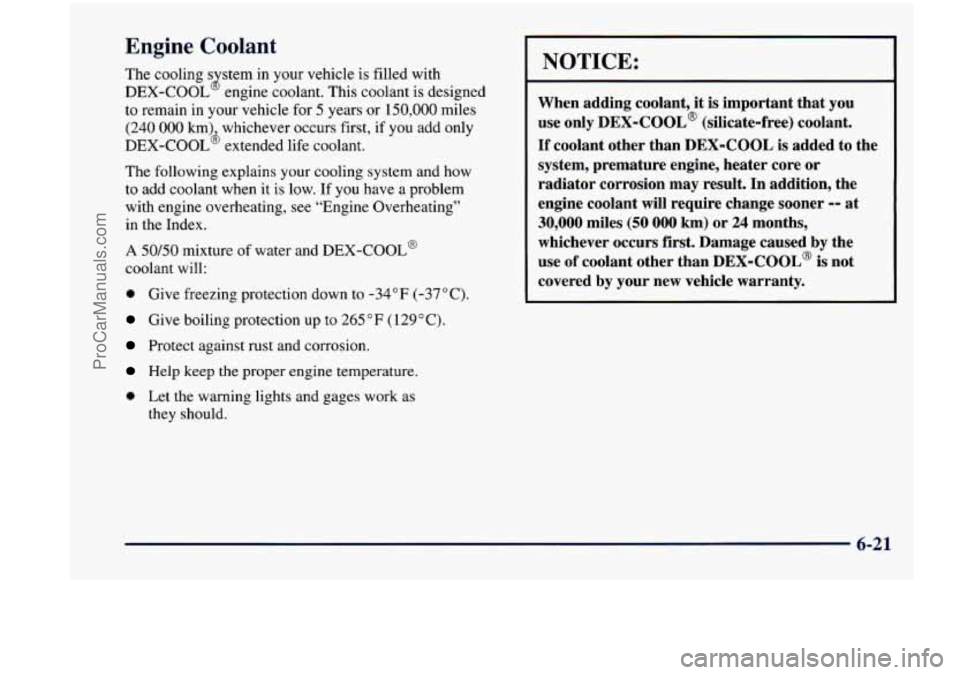
Engine Coolant
The cooling s stem in your vehicle is filled with
DEX-COOL engine coolant. This coolant is designed
to remain
in your vehicle for 5 years or 150,000 miles
(240 000 km) whichever occurs first, if you add only
DEX-COOLd extended life coolant.
J
The following explains your cooling system and how
to add coolant
when it is low. If you have a problem
with engine overheating, see “Engine Overheating”
in the Index.
A 50/50 mixture of water and DEX-COOL@
coolant will:
0 Give freezing protection down to -34°F (-37°C).
Give boiling protection up to 265 OF ( 129 O C).
Protect against rust and corrosion.
Help keep the proper engine temperature.
0 Let the warning lights and gages work as
they should.
~
~
NOTICE:
When adding coolant, it is important that you
use
only DEX-COOL@ (silicate-free) coolant.
If coolant other than DEX-COOL is added to the
system, premature engine, heater core or
radiator corrosion may result. In addition, the
engine coolant will require change sooner
-- at
30,000 miles (50 000 km) or 24 months,
whichever occurs
first. Damage caused by the
use
of coolant other than DEX-COOL@ is not
covered by your new vehicle warranty.
6-21
ProCarManuals.com
Page 359 of 474
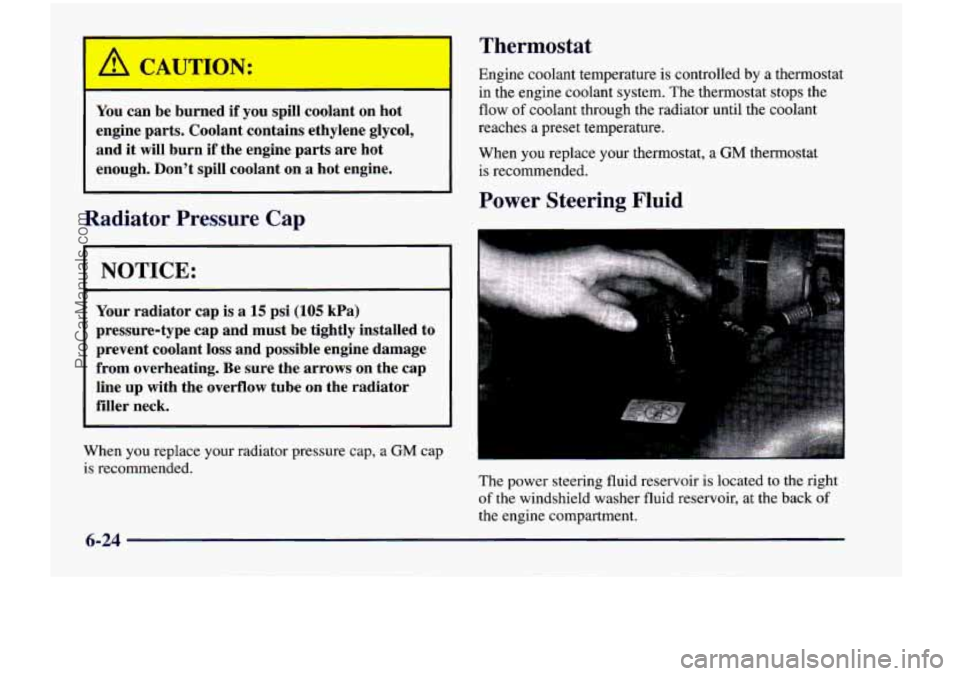
Thermostat
Engine coolant temperature is controlled by a thermostat
in the engine coolant system. The thermostat stops the
flow
of coolant through the radiator until the coolant
reaches a preset temperature.
You
can be burned if you spill coolant on hot
engine parts, Coolant contains ethylene glycol,
and
it will burn if the engine parts are hot
enough. Don't spill coolant on
a hot engine.
Radiator I ressure Cap
NOTICE:
Your radiator cap is a 15 psi (105 kPa)
pressure-type cap and must be tightly installed to
prevent coolant
loss and possible engine damage
from overheating. Be sure the arrows on the cap
line up with the overflow tube on the radiator
filler neck.
When you replace your radiator pressure cap,
a GM cap
is recommended. When you replace your thermostat, a
GM thermostat
is recommended.
Power
Steering Fluid
'l'kv Gower steering fluid reservoir is located to the right
of the windshield washer fluid reservoir, at the back of
the engine compartment.
ProCarManuals.com